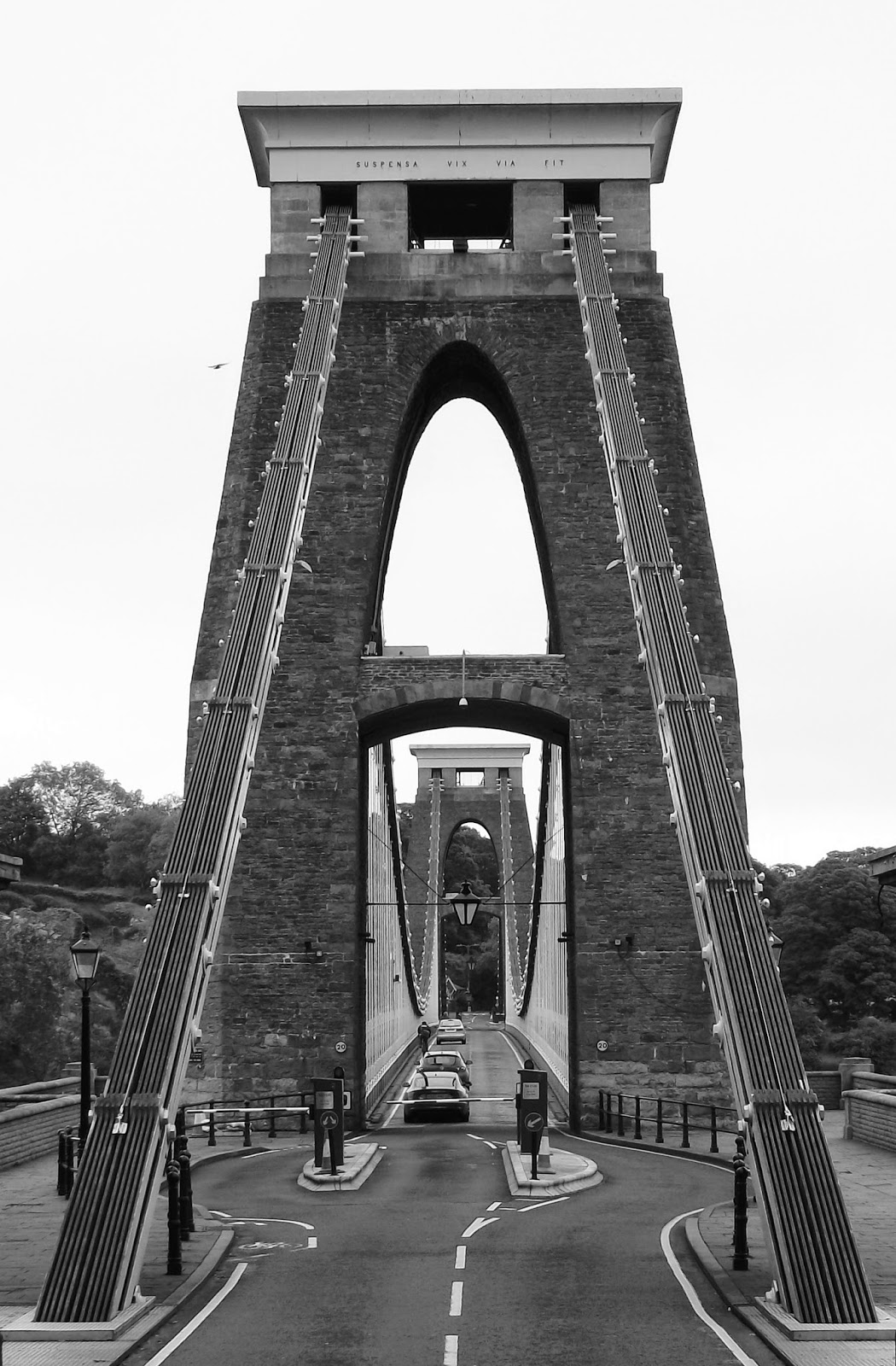Archaeology : Architecture : Art : Cold War : Curiosities : Design : Eccentricities : Ekco : Engineering : Industrial Heritage : Military : Petroliana : Photography : Shed Wonders : Transporter Bridges : Vintage Technology
29 May 2014
Clifton Suspension Bridge - 150 Years
Although one of Brunel's masterpieces, the Clifton Suspension Bridge was neither completed during his lifetime, nor to his design. Commenced in 1831, the structure at Clifton was of the very first generation of wrought iron chain suspension bridges, absolutely at the cutting edge of the engineering of the time. Built at Clifton to take advantage of the relatively narrow width of the Avon Gorge at that point, the deck is 245 feet above high water.
A first design competition was conducted in 1829, three years after Thomas Telford had built his suspension bridge over the Menai Straits. The competition committee asked for Telford's expert opinion on the entries, which included four by Brunel. Telford declared all the designs flawed, and was asked by the committee to submit his own scheme. His short-span suspension bridge was responded to with a new, cheaper, design from Brunel.
Accordingly, a second competition was held in 1830. Smith and Hawkes' scheme was selected as the winner, and Brunel's abutment-based design placed second. Brunel, aged just 24, managed to reverse these placings after private meetings with the committee's expert advisers, and work commenced in June 1831. Four months later a shortage of funds, and riots in Bristol, brought progress to a halt. Work did not re-commence until August 1836, starting with the abutment on the Leigh Woods side. That on the Clifton side, left of picture at top, was commenced in 1839.
The abutments, of grey Pennant rubble stone faced with dressed Old Red Sandstone, are of different heights, to account for the taller and steeper cliff on the Clifton side. They were thought solid until found, in 2002, to be formed of a series of massive chambers. By 1840 the towers, 702 feet apart, 86 feet high, and of about 4,000 tons each, were complete. Next came the anchorages, inclined tunnels cut 60 feet into the cliffs, into the depths of which are carried the ends of the chains. These are locked behind cast iron anchor plates, of 30 square feet, bolted to the rock, and reinforced by 10 feet of Blue Staffordshire brickwork. These were completed in 1842, in which year the towers were topped with cranes to enable construction of the chains.
The chain links, the shortest 24 feet long, had largely been delivered when funds again dwindled. By 1848 the Copperhouse Foundry, Hayle, Cornwall, that had made the links, issued proceedings for payment of its invoices. The debt was repaid only through sale of the chain links, which ended up on the Royal Albert Bridge at Saltash, also by Brunel. The Clifton project came to a second halt in 1853.
Brunel died in 1859. The following year John Hawkshaw designed the Charing Cross railway bridge. This replaced Hungerford Suspension Bridge, another Brunel construction, and Hawkshaw and fellow engineer William Barlow proposed that the Hungerford ironwork be used at Clifton, the links being of the same design as those sold for the bridge at Saltash.
Hawkshaw and Barlow made some design changes - longitudinal deck girders instead of timber trussing, a third chain, and new anchorages - and work re-commenced in November 1862. The Hungerford saddles were installed atop the towers in 1863, and eight wrought iron cables were strung across the void, to provide temporary falsework. The chains, of 4,200 links, were in place by May 1864.
The deck is attached to the chains by way of iron rods, which are in turn bolted to the bottom, middle and top chain, to ease replacement. Once the longitudinal girders were craned into place, the cross bracing was undertaken. The deck itself was formed of five inch thick Baltic pine, laid in two layers, at right angles to each other. The bridge finally opened on 8 December 1864.
The roadway was first asphalted in 1897, and the anchorages strengthened in 1925 (Leigh Woods) and 1939 (Clifton), but, in the main, the structure is just as it was 150 years ago. No steel cables have been added, as has proven necessary with some other early suspension bridges. Brunel didn't see the completed bridge, but he would have known that it was, and is, an engineering marvel.
Labels:
Architecture,
Engineering,
Photography
Subscribe to:
Post Comments (Atom)









No comments:
Post a Comment